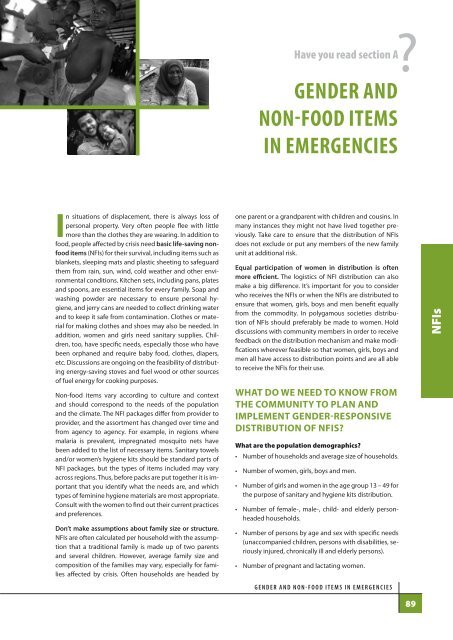Women, Girls, Boys and men - HumanitarianInfo.org
Women, Girls, Boys and men - HumanitarianInfo.org
Women, Girls, Boys and men - HumanitarianInfo.org
Create successful ePaper yourself
Turn your PDF publications into a flip-book with our unique Google optimized e-Paper software.
In situations of displace<strong>men</strong>t, there is always loss of<br />
personal property. Very often people flee with little<br />
more than the clothes they are wearing. In addition to<br />
food, people affected by crisis need basic life-saving nonfood<br />
items (NFIs) for their survival, including items such as<br />
blankets, sleeping mats <strong>and</strong> plastic sheeting to safeguard<br />
them from rain, sun, wind, cold weather <strong>and</strong> other environ<strong>men</strong>tal<br />
conditions. Kitchen sets, including pans, plates<br />
<strong>and</strong> spoons, are essential items for every family. Soap <strong>and</strong><br />
washing powder are necessary to ensure personal hygiene,<br />
<strong>and</strong> jerry cans are needed to collect drinking water<br />
<strong>and</strong> to keep it safe from contamination. Clothes or material<br />
for making clothes <strong>and</strong> shoes may also be needed. In<br />
addition, wo<strong>men</strong> <strong>and</strong> girls need sanitary supplies. Children,<br />
too, have specific needs, especially those who have<br />
been orphaned <strong>and</strong> require baby food, clothes, diapers,<br />
etc. Discussions are ongoing on the feasibility of distributing<br />
energy-saving stoves <strong>and</strong> fuel wood or other sources<br />
of fuel energy for cooking purposes.<br />
Non-food items vary according to culture <strong>and</strong> context<br />
<strong>and</strong> should correspond to the needs of the population<br />
<strong>and</strong> the climate. The NFI packages differ from provider to<br />
provider, <strong>and</strong> the assort<strong>men</strong>t has changed over time <strong>and</strong><br />
from agency to agency. For example, in regions where<br />
malaria is prevalent, impregnated mosquito nets have<br />
been added to the list of necessary items. Sanitary towels<br />
<strong>and</strong>/or wo<strong>men</strong>’s hygiene kits should be st<strong>and</strong>ard parts of<br />
NFI packages, but the types of items included may vary<br />
across regions. Thus, before packs are put together it is important<br />
that you identify what the needs are, <strong>and</strong> which<br />
types of feminine hygiene materials are most appropriate.<br />
Consult with the wo<strong>men</strong> to find out their current practices<br />
<strong>and</strong> preferences.<br />
Don’t make assumptions about family size or structure.<br />
NFIs are often calculated per household with the assumption<br />
that a traditional family is made up of two parents<br />
<strong>and</strong> several children. However, average family size <strong>and</strong><br />
composition of the families may vary, especially for families<br />
affected by crisis. Often households are headed by<br />
?<br />
Have you read section A<br />
genDer AnD<br />
non-FooD Items<br />
In emergencIes<br />
one parent or a gr<strong>and</strong>parent with children <strong>and</strong> cousins. In<br />
many instances they might not have lived together previously.<br />
Take care to ensure that the distribution of NFIs<br />
does not exclude or put any members of the new family<br />
unit at additional risk.<br />
Equal participation of wo<strong>men</strong> in distribution is often<br />
more efficient. The logistics of NFI distribution can also<br />
make a big difference. It’s important for you to consider<br />
who receives the NFIs or when the NFIs are distributed to<br />
ensure that wo<strong>men</strong>, girls, boys <strong>and</strong> <strong>men</strong> benefit equally<br />
from the commodity. In polygamous societies distribution<br />
of NFIs should preferably be made to wo<strong>men</strong>. Hold<br />
discussions with community members in order to receive<br />
feedback on the distribution mechanism <strong>and</strong> make modifications<br />
wherever feasible so that wo<strong>men</strong>, girls, boys <strong>and</strong><br />
<strong>men</strong> all have access to distribution points <strong>and</strong> are all able<br />
to receive the NFIs for their use.<br />
WHAT do WE nEEd To knoW From<br />
THE CommunITy To PlAn And<br />
ImPlEmEnT GEndEr-rESPonSIVE<br />
dISTrIBuTIon oF nFIS?<br />
What are the populat on demograph cs?<br />
• Number of households <strong>and</strong> average size of households.<br />
• Number of wo<strong>men</strong>, girls, boys <strong>and</strong> <strong>men</strong>.<br />
• Number of girls <strong>and</strong> wo<strong>men</strong> in the age group 13 – 49 for<br />
the purpose of sanitary <strong>and</strong> hygiene kits distribution.<br />
• Number of female-, male-, child- <strong>and</strong> elderly personheaded<br />
households.<br />
• Number of persons by age <strong>and</strong> sex with specific needs<br />
(unaccompanied children, persons with disabilities, seriously<br />
injured, chronically ill <strong>and</strong> elderly persons).<br />
• Number of pregnant <strong>and</strong> lactating wo<strong>men</strong>.<br />
G e n d e R A n d n o n - F o o d I T e m S I n e m e R G e n C I e S<br />
nFis











